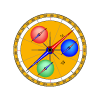Speaker
Gunar Schnell
(University of the Basque Country UPV/EHU)
Description
Fragmentation functions, describing the formation of hadrons from partons, are an indispensable tool in the interpretation of hadron-production data, e.g., in the investigation of nucleon structure via semi-inclusive deep-inelastic scattering. The cleanest process to access fragmentation functions is hadron production in electron-positron annihilation. However, little information can be derived on charge-separated fragmentation functions from single-inclusive hadron production. A better handle on the flavor contributions can be gotten by flavor correlations or tagging: the hadron type in one hemisphere puts constraints on the parton flavor in the other hemisphere and thus on the flavor decomposition of the hadronization process. This can be exploited in inclusive hadron-pair production in electron-positron annihilation. While two hadrons in opposite hemispheres can be used for flavor tagging of single-hadron fragmentation functions, two hadrons in the same hemispheres, e.g., originating from the same parton, open an avenue to a different class of fragmentation functions: dihadron fragmentation functions. They depend not only on the energy fractions of the virtual photon carried by the hadrons but also on the invariant mass of the two hadrons (besides the usual scale dependence). Both scenarios have recently been subject to studies at the Belle experiment. The dependences of the production cross section of pairs of identified light mesons (charged pions and kaons) on the individual z of the mesons or on the combined z and the invariant mass were measured and will be presented as well as discussed in this talk.
Author
Gunar Schnell
(University of the Basque Country UPV/EHU)

